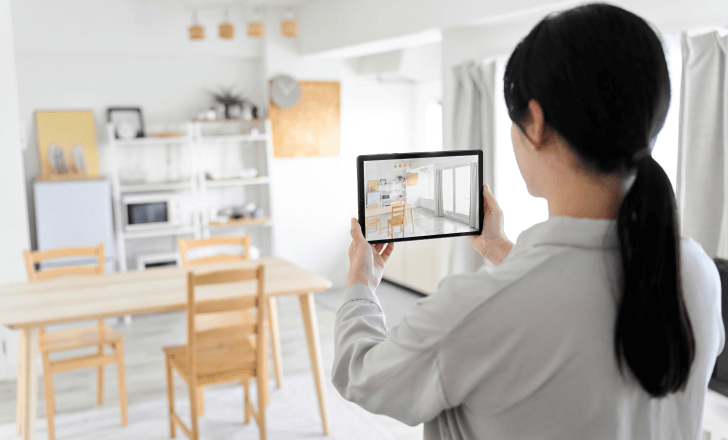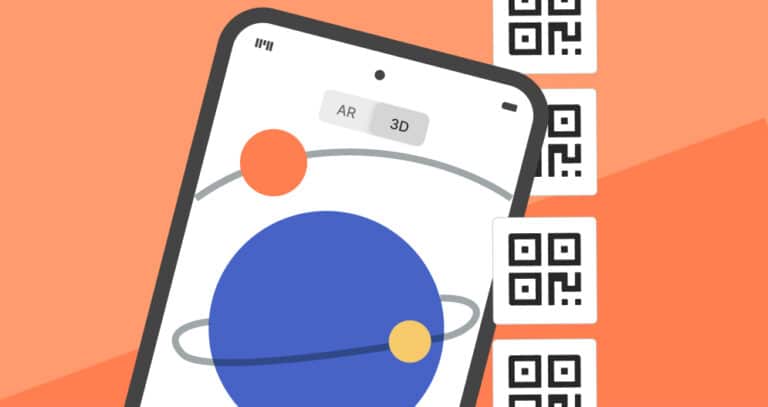Introduction
Augmented Reality (AR) is no longer science fiction. Augmented experiences are now a reality. AR is transforming how we interact with our surroundings. QR codes are at the forefront of this change, serving as powerful entry points to immersive storytelling in augmented reality. Whether in marketing campaigns, print media, or even education, Augmented Reality QR codes are turning static surfaces into dynamic, interactive experiences.
Understanding the basics
What are QR codes?
You’ve seen them everywhere—those pixelated squares on posters, packages, and product tags. But QR codes are more than digital barcodes. They’re smart shortcuts that bridge the gap between the physical world and digital content.
Invented to track car parts, QR codes have come a long way. Today, scan one with your phone and it might take you to a webpage, a video, or even launch a full augmented reality experience. They’re compact, flexible, and increasingly central to how we access information in real time.
Augmented Reality (AR): A brief introduction
Augmented Reality, or AR, brings digital elements into your real-world surroundings—right through your phone’s camera. Think of it as a digital layer that enhances what you see, creating moments that are richer, more informative, and way more fun.
AR technology is everywhere. You can find it in games like Pokémon Go as well as in hospital training simulations. The way we learn, shop, work, and play won’t be the same anymore.
The fusion of QR codes and AR
When you combine QR codes with AR, you unlock a whole new level of interactivity. A single augmented reality QR code can turn a static print ad or product label into a 3D scene, a video walkthrough, or a virtual try-on experience.
This mix makes AR codes more accessible to everyday users. You don’t need to download an app anymore. You can access an AR experience with a simple scan. It’s seamless, instant, and surprisingly powerful.
QR codes in AR applications
AR QR codes in marketing strategy
In today’s crowded market, grabbing attention isn’t easy. But AR QR codes are changing the game. Add one to your product packaging or flyer, and suddenly you’re not just advertising—you’re inviting your target audience into an immersive brand experience.
Picture this: scan a code, and up pops a 3D model of a product, or a scene that tells your brand story through augmented reality. It’s not just eye-catching—it deepens customer engagement and turns your marketing strategy into something unforgettable.
Dynamic QR codes: Bringing interactivity to retail
Static signs are out. Dynamic QR codes are in—and they’re making retail smarter and more personal. Walk into a furniture store, scan a code next to a sofa, and boom—see it in your living room, in any color you want, thanks to AR technology.
But here’s where it gets even better: that same QR code can be updated next week to promote a dining table instead, no reprints needed. Just a new AR experience linked behind the scenes. It’s cost-effective, flexible, and a serious upgrade to the customer experience.
Incorporating AR codes in brick-and-mortar stores
Physical retail is far from dead, but it’s evolving into a new form. Brick-and-mortar stores are using AR codes to bridge the gap between shelves and screens. A quick scan can reveal detailed specs, launch a virtual try-on, or even guide shoppers with an AR-assisted floor map.
It’s all about turning a regular store visit into a smart, interactive experience—one that sticks with customers long after they’ve left.

Technical insights
How an Augmented Reality QR code works
So, how does an Augmented Reality QR code actually work? It all starts with a scan. Inside that pixelated square is more than just data—it’s a launchpad to a full-blown AR experience.
When scanned, these AR QR codes trigger your phone’s camera and overlay digital content—like 3D models, animations, or videos—right into your real world environment. No magic, just clever tech that blends the virtual and the physical into one seamless, interactive experience.
It’s like adding a digital layer to reality, one scan at a time.
QR code generators and AR
You don’t need a specialized tool to make QR codes for augmented reality. With a flexible platform like QR Code KIT, anyone can generate AR codes in just a few clicks.
This means marketers, educators, and content creators can all craft unique, scannable moments—without needing to code or build an app. Whether you’re showing off a new product or sharing educational video content, a good QR code generator gives you the power to design augmented reality experiences tailored to your audience.
And yes, you can choose between static and dynamic QR codes, depending on how much control you want over the content.
Dynamic vs. Static QR codes in AR
In the world of AR applications, knowing the difference between static and dynamic QR codes makes all the difference.
A static QR code is like a printed flyer: once it’s out there, it can’t be changed. It points to one piece of content—forever. A dynamic QR code, though, is much smarter. You can edit where it leads, swap in fresh content, or update the AR experience as your campaign evolves.
That flexibility is gold for marketers and anyone building interactive experiences. You can adapt to what your target customers want—without reprinting a thing.

Marketing and customer engagement
Using QR codes for effective marketing campaigns
When it comes to creating an unforgettable marketing campaign, AR QR codes are a serious power move. Drop one into your ad, and you’re no longer just asking for attention—you’re earning it.
Imagine a billboard with a QR code that launches an AR game featuring your product. It’s not just an ad anymore—it’s a full-on digital experience that people want to engage with. Suddenly, your campaign isn’t just seen. It’s scanned, played with, shared—and remembered.
This kind of interaction doesn’t just increase visibility. It builds stronger brand engagement that sticks.
Customer engagement through AR experiences
The heart of successful marketing lies in deep customer engagement. AR experiences enabled by QR codes can turn passive observers into active participants. Imagine scanning a QR code on a product label and watching the brand story unfold in AR, or seeing how a piece of furniture would look in your living room through an augmented reality experience.
Such interactive elements that incorporate AR codes can significantly elevate the customer and brand experience together, making it more personalized and memorable.

Location-based AR: Connecting physical and digital worlds
Location-based AR, powered by QR codes placed at a particular location, unlocks hyper-personalized, real-time engagement. It’s not just about scanning a code—it’s about where you scan it.
Imagine walking into a retail store and scanning a QR code near the fitting room. Suddenly, you see how a dress would look on you without ever trying it on. Or maybe you’re handed an interactive map that guides you to deals throughout the store—all through your phone and augmented reality.
By anchoring AR experiences to real-world spots, brands can create seamless transitions between physical and digital touchpoints. It elevates the in-store experience, makes shopping more intuitive, and narrows the gap between brick and mortar stores and the convenience of online shopping.
Advanced applications and case studies
Interactive QR codes in education and training
Interactive QR codes are shaking up how we teach and learn. Imagine flipping through a textbook and scanning a code that launches a 3D model of the solar system—or a virtual science experiment you can walk around in real time.
By blending AR code technology with traditional materials, educators can create digital experiences that stick. It’s about diving deeper into subjects with clarity and more accuracy, making lessons come alive in ways that textbooks alone never could.
Augmented reality in online shopping
Let’s face it—online shopping has its limits. But AR QR codes are helping close the gap. Now, a quick scan can let you preview how a new coffee table fits your space or see how those sunglasses look on your face—without leaving your house.
It’s a game-changer, especially for furniture stores and fashion brands. These immersive, augmented reality experiences give shoppers the confidence to click “buy”—turning hesitation into action.
Furniture stores: A case study in AR QR code usage
Furniture retailers are leading the way with creative uses of AR QR codes. Flip through a printed catalog, scan a QR code, and see that couch pop into your living room at scale, in your color of choice.
It’s more than a clever gimmick. It helps people picture how items will actually look and fit in their home—and that makes decisions easier, faster, and way more fun. This kind of fun experience doesn’t just improve the customer experience—it transforms it.

Analytics and feedback
Advanced analytics in AR QR code usage
Behind every AR QR code scan is a story—and advanced analytics help you read it. Retailers and marketers can track everything from how many times a code is scanned to which products are getting the most attention in augmented reality.
Want to know if your target customers are engaging with a certain feature? You’ll see it in the numbers. These insights let you fine-tune your marketing strategy, understand what’s working, and create smarter, more tailored campaigns that drive results.
Customer feedback and AR code technology
Numbers matter, but so does listening. Customer feedback gives you the qualitative edge—real voices telling you how your AR code technology is landing.
Maybe users want smoother navigation, or maybe a certain AR experience left them wowed. Either way, feedback helps shape better, more intuitive interactive QR codes. And in a fast-moving digital world, that ongoing loop of input and improvement is what keeps your brand relevant, responsive, and ahead of the curve.
Future prospects
The future of AR QR codes
The future for AR QR codes isn’t just promising—it’s wide open. With Web AR technology advancing fast and more devices becoming AR-capable, we’re on the brink of a new wave of creative, seamless, and seriously immersive interactive experiences.
Think less friction, more magic. Soon, scanning a QR code might launch holograms, real-time product customizations, or even multiplayer AR games—no app required. As AR technology evolves, expect these experiences to get sharper, faster, and way more engaging.
Challenges and opportunities in AR code technology
Of course, every leap forward comes with a few hurdles. AR code technology still faces challenges—like making sure experiences work across all devices, improving accessibility, and keeping the augmented reality content top quality.
But the upside? It’s massive. As both AR and QR code innovations accelerate, their impact will reach far beyond marketing—shaping how we learn, shop, entertain, and connect. The next chapter in augmented reality is being written now, and QR codes are playing a starring role.
RealityMAX – Enhancing QR codes for AR
RealityMAX: A premier solution for AR QR codes
As a truly standout platform for creating AR QR codes, RealityMAX combines power with simplicity, offering an intuitive, no-code, no-download approach that makes immersive AR creation accessible to anyone.
Whether you’re building a marketing campaign or designing a virtual showroom, RealityMAX makes it easier, faster, and far more creative.
Collaborative and real-time 3D design
Collaboration is at the heart of RealityMAX. Their promise—“The one-stop platform for building, collaborating, and sharing 3D projects”—it’s a core strength.
When it comes to creating QR codes for AR, especially at scale, real-time teamwork is a game-changer. Designers, marketers, and developers can all jump into the same workspace, working together to refine and launch experiences that are polished, professional, and totally engaging.
Building reliable AR experiences with RealityMAX
Our collaboration with RealityMAX reinforces one big idea: delivering AR that’s both exciting and dependable. With its rock-solid infrastructure and real-time tools, RealityMAX helps us offer AR QR codes that don’t just look good—they perform flawlessly.
From interactive product demos to immersive educational tools, this platform makes it easy to build experiences that audiences can trust and enjoy, across any device or campaign
The future of QR codes for AR with RealityMAX
Looking ahead, we see endless potential in the partnership between our platform and RealityMAX. Together, we’re unlocking new creative possibilities in the world of AR QR codes—and the results are already turning heads.
With real-time 3D collaboration, streamlined workflows, and a user-friendly interface, RealityMAX is shaping the future of AR technology. And we’re proud to be building that future side by side.

Conclusion
QR codes for Augmented Reality are a leap forward in how we connect with digital content. By blending the physical and virtual worlds, these codes unlock a new kind of interaction: more personal, more immersive, and way more memorable.
Whether you’re a brand, educator, or creator, the opportunities are growing fast. As AR technology keeps evolving, the line between real and digital will keep fading—opening doors to richer, smarter, and more engaging experiences than ever before.
